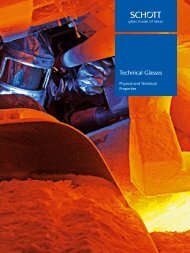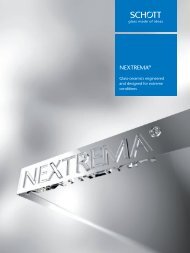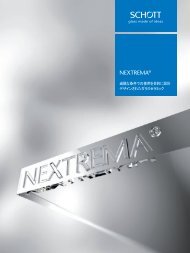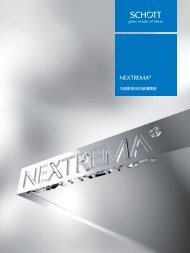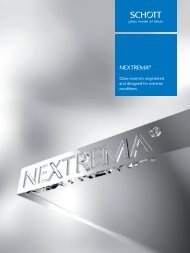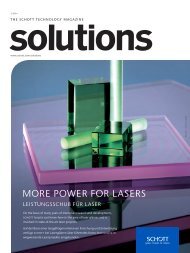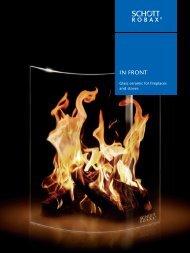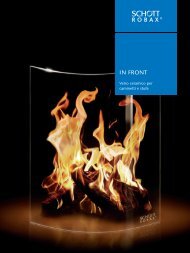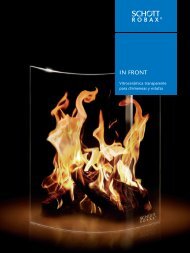Technology Magazine "SCHOTT solutions" - Edition 2/2013 - Technologie Magazin "SCHOTT solutions"
A variety of SCHOTT innovations The latest issue of our technology magazine “solutions” discusses innovations our SCHOTT experts are developing, how they provide support for our customers as partners and how they are addressing tomorrow’s challenges today. Our broad range of products and materials opens up a wide variety of different topics ranging from the universe all the way to the nano cosmos. We wish you enjoyable reading! Spannende Stories über SCHOTT Innovationen Die neuste Ausgabe des Technologiemagazins „solutions“ verrät, was SCHOTT Experten entwickeln, wie sie Anwendern kompetenter Partner sind und die Herausforderungen von morgen schon heute anpacken. Unsere breite Produkt- und Materialpalette erschließt dabei ein weites Feld: vom Weltall bis in den Nanokosmos. Viel Spaß beim Lesen!
A variety of SCHOTT innovations
The latest issue of our technology magazine “solutions” discusses innovations our SCHOTT experts are developing, how they provide support for our customers as partners and how they are addressing tomorrow’s challenges today. Our broad range of products and materials opens up a wide variety of different topics ranging from the universe all the way to the nano cosmos. We wish you enjoyable reading!
Spannende Stories über SCHOTT Innovationen
Die neuste Ausgabe des Technologiemagazins „solutions“ verrät, was SCHOTT Experten entwickeln, wie sie Anwendern kompetenter Partner sind und die Herausforderungen von morgen schon heute anpacken. Unsere breite Produkt- und Materialpalette erschließt dabei ein weites Feld: vom Weltall bis in den Nanokosmos. Viel Spaß beim Lesen!
You also want an ePaper? Increase the reach of your titles
YUMPU automatically turns print PDFs into web optimized ePapers that Google loves.
Fiber optic plates are used in round and rectangular<br />
shapes. <strong>SCHOTT</strong> produces the latest generation<br />
RFG92 in sizes up to 320 mm x 320 mm.<br />
Photo Foto : schott/ H. Fischer<br />
Optische Faserplatten werden in runden oder<br />
rechteckigen Formen eingesetzt. Die neue<br />
Generation RFG92 stellt <strong>SCHOTT</strong> bis zu einer<br />
Größe von 320 mm x 320 mm in Serie her.<br />
turn, reduces the so-called noise floor. These interference signals<br />
occur inside the sensor as a result of x-ray radiation and can overlap<br />
the light signals and make it very difficult to read them. Fiber optic<br />
plates limit this and, at the same time, increase the contrast of the<br />
x-ray image quite significantly. <strong>SCHOTT</strong> will now be introducing a<br />
new generation of these types of products under the name RFG92.<br />
These fiber optic plates are manufactured using a modified glass<br />
material that meets all of the relevant RoHS standards and does<br />
not contain substances that are harmful to the environment.<br />
Unlike other manufacturers, <strong>SCHOTT</strong> is capable of offering monolithic<br />
square formats up to 320 millimeters in length. This offers<br />
advantages over products that consist of multiple glued fiber optic<br />
plates because the lines of glue are picked up by the image sensor<br />
and can often only be extracted by software at the expense of reading<br />
speed. Glue lines also offer no x-ray attenuation, therefore this<br />
increases the risk of noise and the sensor being damaged. Last, but<br />
not least, glued fiber optic plates are more sensitive to mechanical<br />
stresses than monolithic plates.<br />
"We have developed an environmentally-friendly product that<br />
requires no RoHS exemption permits and fully meets today’s<br />
market demands in terms of both its technology and its price,”<br />
explains Jörg Warrelmann. The Senior Product Manager for<br />
Medical at <strong>SCHOTT</strong> Lighting and Imaging sees areas of application<br />
in mainly large-format flat image detectors such as those that<br />
are used to produce large cardiovascular images and in dynamic<br />
3-D or mammogram x-rays in the future. Further market potential<br />
also exists in a completely different field: industrial technical<br />
in-line inspections during which parts are scanned at extremely<br />
high speeds. <<br />
joerg.warrelmann@schott.com<br />
besitzt eine sehr gute Transmission für sichtbares Licht sowie eine<br />
hohe Röntgendämpfung. Das heißt, sie lässt das vom Szintillator<br />
umgewandelte Licht passieren, blockt aber Röntgenstrahlen ab.<br />
Die gute Röntgendämpfung sorgt zudem für eine Reduzierung des<br />
sogenannten Grundrauschens. Diese Störsignale entstehen im<br />
Sensor infolge der Röntgenstrahlung und können je nach Stärke<br />
die Lichtsignale überlagern und deren Auslesung beeinträchtigen.<br />
Faserplatten beschränken dies und erhöhen zugleich den Kontrast<br />
des Röntgenbildes beträchtlich. Eine neue Generation solcher<br />
Produkte führt <strong>SCHOTT</strong> nun unter dem Namen RFG92 ein. Die<br />
Faserplatten werden auf Basis eines modifizierten Glasmaterials<br />
ohne Zusatz von umweltgefährdenden Stoffen hergestellt und<br />
erfüllen alle entsprechenden RoHS-Standards. Im Unterschied<br />
zu anderen Anbietern kann <strong>SCHOTT</strong> quadratische Formate bis<br />
320 Millimeter Seitenlänge in einem Stück anfertigen. Dies schafft<br />
Vorteile gegenüber Produkten, die aus mehreren verklebten Faserplatten<br />
bestehen. Denn die Klebelinien werden vom Bildsensor<br />
erfasst und lassen sich nur auf Kosten der Lesegeschwindigkeit<br />
per Software herausrechnen. Auch bringen Klebelinien keinerlei<br />
Röntgendämpfung mit. Damit erhöht sich das Risiko für<br />
Rauschen wie auch für eine Schädigung des Sensors. Nicht zuletzt<br />
sind geklebte Faserplatten empfindlicher gegen mechanische<br />
Belastungen als monolithische Platten.<br />
„Wir haben damit ein umweltfreundliches Produkt entwickelt,<br />
das ohne RoHS-Ausnahmegenehmigungen auskommt und den<br />
heutigen Marktansprüchen technisch und preislich voll entspricht“,<br />
resümiert Jörg Warrelmann. Der Senior Product Manager Medical<br />
bei <strong>SCHOTT</strong> Lighting and Imaging sieht dafür Anwendungsfelder<br />
in kleinen, vor allem aber in großformatigen Flachbilddetektoren,<br />
wie sie etwa für großflächige kardiovaskuläre Aufnahmen<br />
gebraucht werden und in Zukunft auch verstärkt für dynamisches,<br />
3D- oder mammografisches Röntgen zum Einsatz kommen sollen.<br />
Weiteres Marktpotenzial besteht in einem völlig anderen Sektor:<br />
in der industrietechnischen In-Line-Inspektion, bei der in schnellen<br />
Taktraten Teile gescannt werden. <<br />
joerg.warrelmann@schott.com<br />
37






